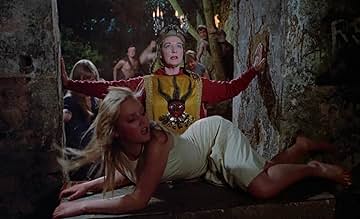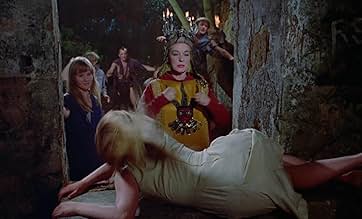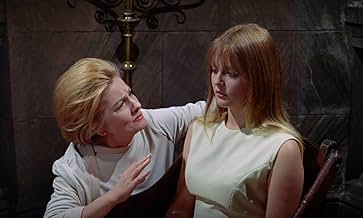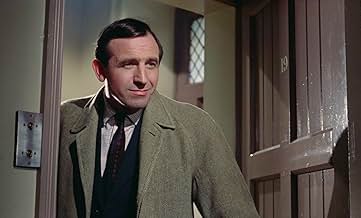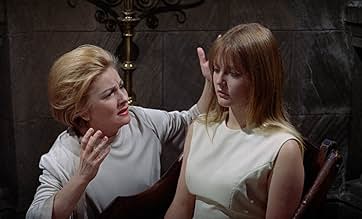Aggiungi una trama nella tua linguaFollowing a horrifying experience with the occult in Africa, a schoolteacher moves to a small English village, only to discover that black magic resides there as well.Following a horrifying experience with the occult in Africa, a schoolteacher moves to a small English village, only to discover that black magic resides there as well.Following a horrifying experience with the occult in Africa, a schoolteacher moves to a small English village, only to discover that black magic resides there as well.
- Linda Rigg
- (as Ingrid Brett)
- Granny Rigg
- (as Gwen Ffrangcon-Davies)
- Mark
- (non citato nei titoli originali)
- Mrs. McDowall
- (non citato nei titoli originali)
- Mr. Glass
- (non citato nei titoli originali)
Recensioni in evidenza
As boss witch supreme Stephanie Bax, a character one of the reviewers of the time described as a "lesbian-like writer," Kay Walsh dominates the action from the moment she appears. Of all the various witch films of the Sixties, this one probably has the most realistic atmosphere and the most plausible plot. The traditional opposition between village wise women (capably embodied here by Gwen Ffrangcon-Davies as Granny Riggs--be sure to keep an eye out for her stogie-chomping aristo witch in 1967's The Devil Rides Out) and the kind of ceremonial magician played by Miss Walsh is portrayed quite matter-of-factly in the script. The kind of witchcraft practiced both by the Walsh and the Ffrangcon-Davies characters is a pretty accurate portrayal of practices actually current in Sixties England, for instance in the circles around Robert Cochrane and other figures who were gaining a lot of media attention in those days. The campy elan of Miss Walsh's dances as High Priestess (one wonders how they dealt with all the hot wax that must have flown off the lit candles in that antler-crown of hers) is very London West End on one level, yet also seems a poetic evocation of a learned ceremonial magician taking over a traditional village circle for her own corrupt ends on another level. Excellent work by Miss Walsh and the choreographer.
Also worthy of mention is the appearance of Martin Stephens, who made memorable such earlier Sixties fantasy films as The Innocents and Village of the Damned (in which he had the unenviable task of acting opposite George Sanders--who hated children!). Martin retired from films shortly after appearing in the Witches. Among the others, Alec McCowen turns in a brilliant little gem of a performance as Kay Walsh's traumatized brother.
For all its excellence, Hammer historians give second place for this film to Don Sharp's 1964 outing, Witchcraft. Let's hope somebody hurries up and releases that one on home video soon!
One of the lesser known horror movies from legendary British Hammer films, this was also Joan Fontaine's last role. It's a slow and surprisingly tame movie, but well-made and atmospheric. While it's nothing outstanding, it certainly is worth watching. The ending may be a bit of a letdown. I also liked the music score during the opening credits, and some bits of the soundtrack are really good.
Except for the hokey demon in the opening, the first part is nicely understated. Life at the English school seems normal enough even if the business with the dolls is a little unsettling. As a result, we can't be sure what's developing, which for me generates suspense since we know something sinister is afoot but can't be sure what. Frankly, I wish the movie's remainder had remained in this understated vein, with a creepy upshot instead of the wildly misguided finale.
With an actress of Fontaine's caliber, it would have been possible to develop this dark psychological aspect, which, for example, is nicely done at the rest home, but soon gives way to silly high-priestess antics (Bax). I guess Hammer figured audiences expected a big lurid payoff leaving nothing to the imagination, which is just what they provided. Anyway, the film's colorfully set in the English countryside, and smoothly directed by Frankel. But for those of us that believe the most effective horror lies in an aroused imagination, the movie proves an ultimate disappointment.
Joan does a fine job in her final movie. She would do some more TV work but this is it for her long film career. The rest of the cast is made up of solid British actors. Cyril Frankel's direction is good. He manages to evoke a fair amount of atmosphere for a picture that takes place almost entirely in daylight. In some ways it's a precursor to The Wicker Man. It's nowhere near as good as that film but there are some similar plot elements. The screenplay is from Nigel Kneale, best known for being the creator of Professor Quatermass and for his screenplay for the excellent 1957 Abominable Snowman film. Reportedly Kneale was dissatisfied with this film because he intended it to be a dark comedy that poked fun at witchcraft but Hammer wanted a serious horror movie so all comedic touches were removed. Well they missed a few because some of the most memorable parts of the movie, such as Joan being overrun by a flock of sheep and every scene of Kay Walsh in her pagan ritual get-up, are very funny. It's a decent movie of its type. Not really scary but interesting, particularly for Fontaine fans.
Lo sapevi?
- QuizThis was Joan Fontaine's final film, perhaps due to its poor box office reception, though she continued to work consistently in television well into the 1980s (one final project came in 1994).
- BlooperWhen Linda starts dancing in the finale, Tom's position changes between long shots and close-ups.
- Citazioni
Gwen Mayfield: Look at this! Stuck full of pins and it's head missing. What do you think it could possible be?
Stephanie Bax: Witchcraft? Somebody having a little dabble? Yes, I would think so. Or did you think I was going to say, no no no, it can't happen here? I bet there are lots of remote spots where remnants of witchcraft are still practiced. Places like Heddaby, in fact. I've often wondered.
Gwen Mayfield: Well, what are we going to do?
Stephanie Bax: Do? Ah.
Gwen Mayfield: Well, I'd like to start by removing those pins.
Stephanie Bax: Yes, we could- Oh, no! Emphatically not! Do you see why? Well, that would mean admitting belief in it all, for ourselves I mean.
Gwen Mayfield: Oh, I see!
Stephanie Bax: I did some articles on witches once. No, not witches, damn them, people who thought they were witches. The psychology of it. It's a sex thing deep down, of course, mostly women go in for it, older women.
Gwen Mayfield: Like, um, Mrs. Rigg, for instance?
Stephanie Bax: Yes. They relish the idea of a secret power, especially when their normal powers are failing. Now, they may believe in it, the point is, do we? What are we giving into if we admit the possibility that a healthy young kid can be put in hospital by mere ill will? That's where it gets fascinating.
Gwen Mayfield: I see, what we admit we believe and what we believe I suppose, could destroy us.
Stephanie Bax: Beautifully put.
- ConnessioniFeatured in The World of Hammer: Wicked Women (1994)
I più visti
- How long is The Witches?Powered by Alexa
Dettagli
- Data di uscita
- Paese di origine
- Lingua
- Celebre anche come
- Bajo la sombra del infierno
- Luoghi delle riprese
- Aziende produttrici
- Vedi altri crediti dell’azienda su IMDbPro
- Tempo di esecuzione1 ora 30 minuti
- Proporzioni
- 1.66 : 1
Contribuisci a questa pagina



